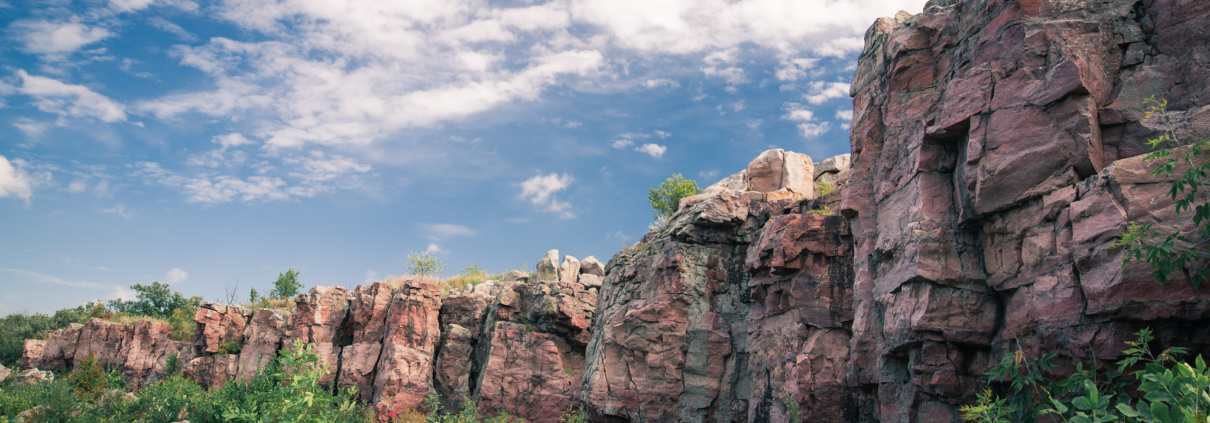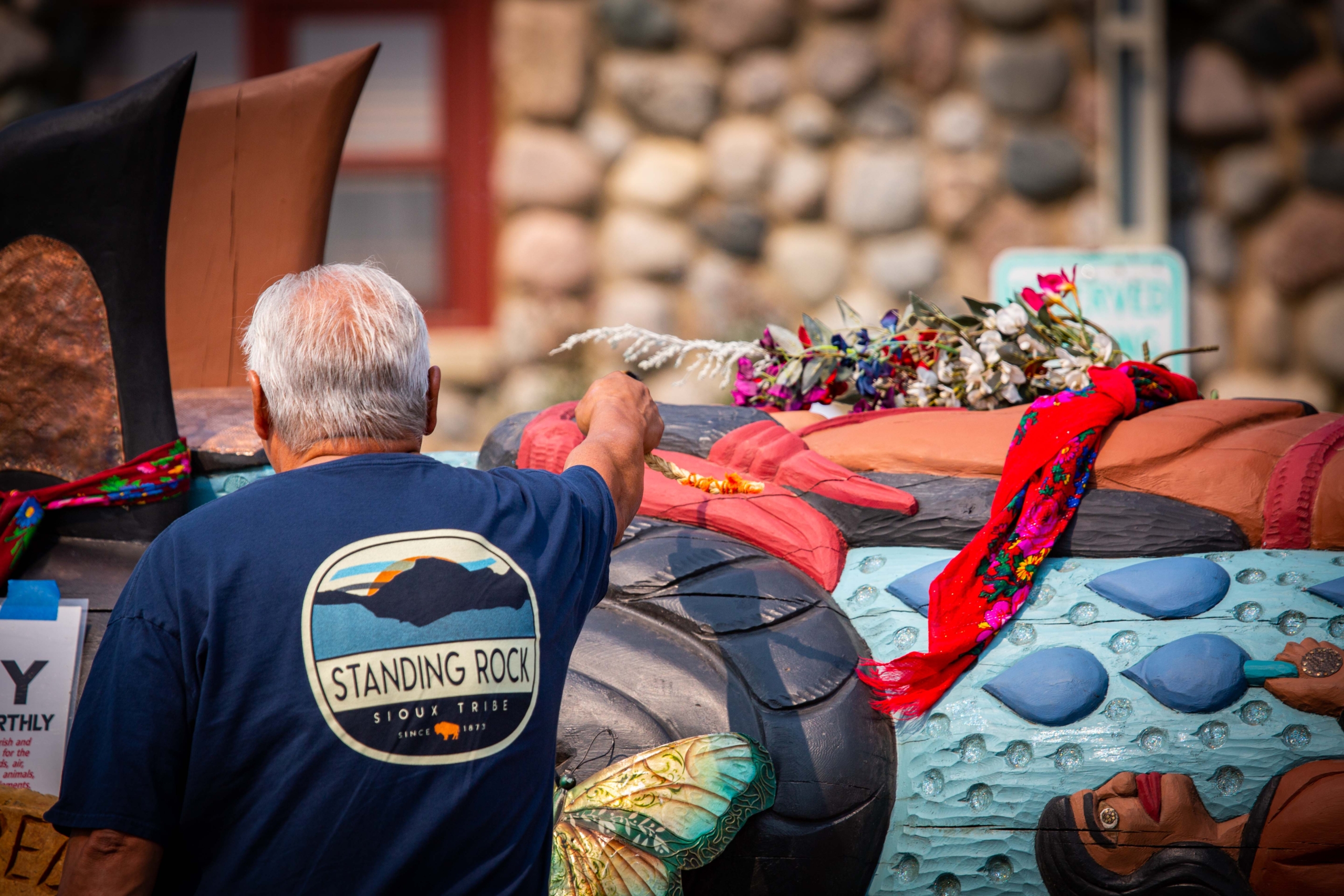Tag Archive for: pipeline
Keystone XL Pipeline is Canceled
On January 20th, 2021 President Joe Biden signed an executive order to cancel the permit for construction of the Keystone XL pipeline.
Native Organizers Alliance has been a partner in the Promise to Protect network of Indigenous activists and Tribal leaders who have been leading the resistance against these extractive industries for over 10 years.
Putting Solar Panels in Pipeline’s Path, Campaign to Combine Power of Sun ‘With Power of the People’
An Indigenous-led coalition is fundraising to install solar panels along the route of TransCanada’s Keystone XL pipeline to protest the project and provide renewable energy to family farms and Native communities in Nebraska and South Dakota.
“In the fight against dirty tar sands oil from crossing Indigenous treaty lands, we must also take moments to highlight the things we are fighting for,” explained Indigenous Environmental Network campaigner Dallas Goldtooth. “We will not only build renewable energy in America’s breadbasket, on Indigenous lands for Indigenous people, demonstrating the goals of a just transition towards sustainable energy, but we will build it in the face of the Keystone XL pipeline.”
“The fight against Keystone XL has always been about more than one pipeline—we’re demanding a world free of dirty fossil fuels,” added 350.org executive director May Boeve. “Putting solar in the path of this pipeline models the massive overhaul our energy system needs to stop the worst of climate change.”
This effort is just the latest phase of the Solar XL campaign launched last year by the Indigenous Environmental Network, Native Organizers Alliance, Brave Heart Society, Dakota Rural Action, Bold Nebraska, and 350.org. The groups installed an earlier round of solar arrays last summer.
The activists and landowners—who are also fighting the pipeline’s development in court—are optimistic about the message the new solar installations will send to politicians and the public alike, and compared the effort to mass demonstrations against the Dakota Access Pipeline.
“The powerful thing about alliances for mother earth is when they create a space to unlearn fear and to relearn leadership. This was true at Standing Rock, and Solar XL is another chance to learn and build a shining example of the future we want,” said Faith Spotted Eagle, a member of the Yankton Sioux Nation and the Brave Heart Society. “Our efforts to fight Keystone XL combines the power of solar with the power of the people.”
With a fossil fuel-friendly Republican Party in control of the White House and Congress, anti-Keystone XL activists continue to emphasize the importance of building broad opposition to the dirty energy industry and the politicians that back it.
“While Trump and fossil fuel executives continue to deny the writing on the wall, our resistance must grow stronger,” declared Boeve, referencing moves such as the administration’s attempt to save struggling coal and nuclear plants with a taxpayer-funded bailout. “We already know the just way forward is with renewable energy solutions like solar and wind, now we need the will.”
“Projects like Solar XL, built with grassroots financial support and owned by Indigenous communities and family farmers, are our best hope for a future of sustainable energy that delivers us from dependence on fossil fuels and the harm caused by extractive industries,” concluded Native Organizers Alliance director Judith LeBlanc Caddo.
The coalition has produced a video sharing the stories of families and communities who would be impacted by the pipeline:
Reprinted from CommonDreams.org
Native People and Allies Pledge to Stop Keystone XL
I’m in Lower Brule, South Dakota, where elected tribal officials, spiritual leaders, Native grassroots organizations, youth groups, and traditional women’s societies have gathered with non-Native farmers, ranchers and others affected by the Keystone XL pipeline. That project to carry tar sands from shale fields in Canada to the Gulf of Mexico threatens our water, our livelihoods and our sacred sites.
We were together Monday when we heard the news Nebraska’s Public Services Commission gave approval to an alternative route for the pipeline.
Yes, we were sad, and angry. But within minutes, we went from being sad to being strategic. That decision opens a new terrain to continue the fight to prevent the building of KXL, and it can be stopped if we build on the strong relationships between Native leadership and non-Native farmers and ranchers. We can leverage the power of organized prayer in a values-led campaign that puts Mother Earth above profit-hungry fossil fuel corporations.
What We Learned in Standing Rock
Many of us are veterans of Standing Rock. We learned so much during those long, cold months at the Oceti Sakowin camp, in our struggle to stop the Dakota Access Pipeline.
We won at Standing Rock, even though the oil is now flowing. Because over 400 tribes came together to stand with the Standing Rock Sioux Tribe for their sovereign, moral and inherent right to protect the Missouri River and Mother Earth.
Native peoples have a unique role to play in building a movement that defends the planet, and in creating a future where we all can live in healthy communities.
Joining Our Struggle
What began as a struggle to protect the Standing Rock Sioux Tribe’s water supply and sacred sites grew into an international movement to protect the water for the 17 million people who live, work and play along the shores of the Missouri. Along the way, we were joined by by thousands more from all around the world.
As we believe, we’re all related, and that all we do in life, and nature has an impact on every one of us.
So the mood at our gathering today is that in the present, we can act on the wisdom and knowledge of our ancestors, and protect future generations from destruction if we work strategically. We must lead with love for humanity, for community and for Mother Earth.
We must plan and organize, not just politically, but also with the prayers that will give us the strength and courage to do what we need to do to stop this pipeline. Tribal leadership and Native communities are the keys to winning this struggle.
TransCanada Knows
The truth is that TransCanada, the pipeline’s builders, aren’t happy. Nebraska allowed their project to proceed, but they didn’t get what they wanted. A new route means TransCanada has to decide if the costs of proceeding are worth it.
TransCanada’s investors must face questions of the viability of building a pipeline that has been fought for years as oil prices have dropped. Quarterly earnings come out December 9, and their shareholders meet on December 15. According to the New York Times, they still haven’t decided whether they will proceed with building the pipeline.
The price of oil is still low. And the movement we started at Standing Rock succeeded in the divestment of $5 billion from the Dakota Access Pipeline. City governments, union pensions and individuals were convinced by the power of the Oceti Sakowin Camp that it was immoral to have their money fund that pipeline. We can do the same with Keystone XL, and TransCanada’s investors know it.
What We See
So what we see here in Lower Brule is that all up and down the new proposed route, there are possibilities to challenge the building of Keystone XL.
Sadly, we’re also gathered near where 210,000 gallons are leaking from the Keystone 1 pipeline. TransCanada has proven that they’re not prepared to deal with this kind of calamity, nor can they protect the precious aquifer and wells that are critical for ranching, irrigating crops and drinking water.
The movement to stop Keystone XL has momentum, because it is grounded in the Indigenous practices of living in harmony with nature. Ourstrategy and tactics are rooted in the inherent responsibility of indigenous communities to do whatever is necessary to protect the land, water and air from destruction.
Our Power Has Grown
Response to this week’s KXL permit decision comes out of years of united resistance between Native and non-Native landowners. Our power has grown since Standing Rock. People now understand that if we build unity, if we build a movement with compassion for Mother Earth and concern for Humankind, we can win the hearts and minds of a broad cross section of people in this country.
And if we beat Keystone XL, we can disrupt the pro-fossil fuel campaign coming from the White House. We will signal an unmistakable challenge to all those running for office in states where American Indians are concentrated that the Native vote is the swing vote, which will be mobilized all the way from prayer camps to the voting booth.
There’s a very keen awareness that this fight is important not only for those who live along the pipeline, but also for how our country can become less dependent on fossil fuels, and we can move towards the protection of our planet.
A Family Reunion
So here in Lower Brule, we’re holding a family reunion: veterans of the first successful KXL fight, the Standing Rock family, with newcomers, Natives with non-Natives. Strategizing, sharing stories and renewing our shared commitment to protecting the sacred from desecration by fossil fuels has made us even stronger.
But the coming battles are going to be new, not like the ones in the past, and will demand all our strength. The traditional indigenous practice is that you must respond to adversity with courage, humility, compassion and love of community as we always have.
The NO KXL movement is being built from a spiritual starting point that’s rooted in the traditional Lakota, Dakota culture and origin stories, in the grassroots and in sovereign treaty rights that have been so often ignored.
Wherever You Are
Together with our allies like 350.org, Greenpeace, and Rainforest Action Network, we “Promise to Protect the Sacred.” So if the need arises, if we have exhausted all local avenues, when we need assistance, people from all over the world will be called to come to Nebraska and South Dakota to physically stop the building of this pipeline.
Wherever you are, please take a moment to remember think about how you can be a part of this historic movement to stop Keystone XL.
Native peoples have a legal, moral, spiritual and inherent right to be caretakers of the planet. The sacred teachings of our cultures reflect the resilience that has brought us this far, by prioritizing kinship, reciprocity and community building. It’s about preserving relationships and living in balance, with all things – natural, human and animal.
Reprinted from CommonDreams.org
Native People Waging Historic Struggle Against Dakota Access Pipeline
A historic struggle is brewing in North Dakota, where hundreds of Native Americans have mobilized to oppose the construction of a major oil pipeline across the Missouri River.
Local tribal members and their supporters have gathered near Cannonball, North Dakota in a large and growing prayer camp, unified behind the slogan Mni wiconi, meaning “water is life” in the Lakota language.
The Dakota Access Pipeline they are standing against is designed to move he pipeline would eventually haul 470,000 barrels of crude oil a day from the Bakken oil fields in North Dakota 1,172 miles to Illinois and refineries further south.
Given the troubling record of pipeline safety in the U.S. the Standing Rock Sioux Tribe is gravely concerned that the pipeline’s planned path across the Missouri River is just one mile upstream from the 8,000-person reservation. The Missouri is the tribe’s only source of water. The pipeline will also disturb sacred sites on land managed by the Army Corps of Engineers.
Last weekend The New York Times featured a front-page photo of young Native activists on horseback across from a line of law enforcement officers near the planned pipeline construction site. In fact, the peaceful stand by American Indian volunteers against this Big Oil project is getting more mainstream coverage than just about any Native issue in memory.
But little of the reporting captures the truly historic nature of the conflict.
The fight against the Dakota Access Pipeline is shaping up to be a rallying cry for indigenous people across the continent and for the broader climate movement as well. And it’s not going away anytime soon.
The Camp of the Sacred Stones prayer encampment was initiated by members of the Standing Rock Sioux Tribe back in April to little national notice. But news of the heroic opposition to the Dakota Pipeline soon spread across Indian Country by word of mouth and social media — which has become one of the main venues of solidarity and struggle for Native peoples in recent years.
“We have laws that require federal agencies to consider environmental risks and protection of Indian historic and sacred sites,” Dave Archambault II, the elected chairman of the Standing Rock Sioux Tribe, said in a statement. “But the Army Corps has ignored all those laws and fast-tracked this massive project just to meet the pipeline’s aggressive construction schedule.”
As of the beginning of August, local authorities had arrested nearly two dozen peaceful protesters, including elected tribal leaders. The tribe filed a formal injunction to halt construction on the pipeline, about which they say they were not consulted. North Dakota Governor Jack Dalrymple then declared a state of emergency and put the National Guard on call despite the peaceful nature of the camp. Morton County Sheriff Kyle Kirchmeier attempted to stoke local tensions by declaring, “It is turning into an unlawful protest with some of the things that have been done and have been compromised at this point. We have had incidents and reports of weapons, of pipe bombs, of some shots fired.”
Organizers and leaders strongly deny these claims. All firearms, weapons, alcohol and drugs are strictly forbidden in the camp, which is home to many families and young children.
When the governor closed local roads and used blockades to corral the camp, the North Dakota ACLU responded by stating, “If the highway remains closed and we receive additional information regarding violations of the rights of individuals to protest peacefully, we will pursue all legal remedies available to us to prevent further abuses. We ardently hope that the government works with us to ensure that peaceful protest is permitted and not hindered by governmental action.”
Now, the camp hosts as many as 3,000 people, many from Standing Rock reservation, but many more from an estimated 100 other tribes from around the country. Hundreds of volunteers maintain kitchens, campsites, cleanup and logistics for the encampment. Hundreds of long-term and short-term visitors have made their way to Cannonball to show solidarity and stand with Standing Rock.
According to some observers, the gathering near Standing Rock is the broadest political gathering of indigenous tribes of North America in modern times. Almost daily shipments of drinking water, food, supplies, or tribal delegations arrive in the camp.
“The atmosphere at the Camp of the Sacred Stones is transformative,” said Judith Le Blanc, a member of the Caddo tribe and director of the Native Organizers Alliance who spent a week at the camp. “It is a community taking care of each other, the land and the water… Many people who are making the camp their home have never been activists before. They came here as protectors, not protesters.”
The encampment has grabbed attention in part because it’s a classic David and Goliath Story.
The $3.7 billion Dakota Access pipeline is backed by big money (a consortium that includes the owners of Sunoco gasoline) and is bolstered by promises of jobs and support from elected officials of both major parties.
Sections of the pipeline across all four states have already been built, but Dakota Access faces opposition elsewhere as well. On Wednesday, members of Iowa Citizens for Community Improvement (Iowa CCI) and Bold Iowa beat back an attempt to silence protests of the pipeline in that state.
“We have been in this pipeline fight for over two years, and have vowed to use all of the tools available to us in our fight,” said Adam Mason, State Policy Director at Iowa CCI. “We will not be deterred or bullied by Big Oil.”
In late August a federal judge postponed ruling on the injunction until September 9, with a backup date for any appeals set for September 14. Whatever the ruling, there is a big struggle ahead in the courts and on the soil of North Dakota – and people around the world will continue to stand with Standing Rock.
Originally appeared at Ourfuture.org




